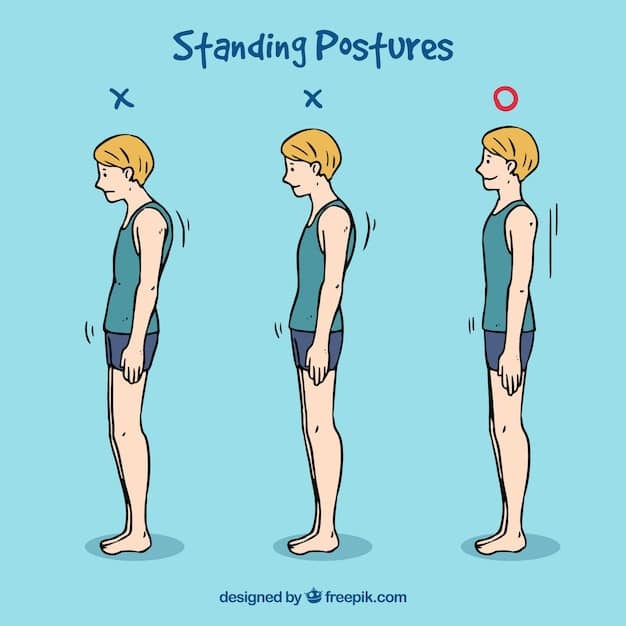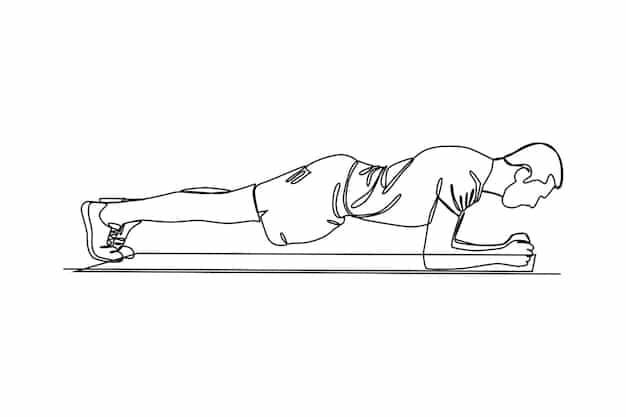Improve Posture & Reduce Back Pain: Tips & Exercises

Improving your posture and reducing back pain involves practical tips and exercises, including ergonomic adjustments, regular stretching, and strengthening exercises to support spinal alignment and alleviate discomfort.
Do you suffer from persistent back pain or find yourself constantly slouching? You’re not alone. Many people experience discomfort and poor posture due to sedentary lifestyles, prolonged screen time, and lack of awareness. This article provides practical tips and exercises to how to improve your posture and reduce back pain, leading to a healthier and more comfortable life.
Understanding the Importance of Good Posture
Good posture is more than just standing up straight. It’s about training your body to stand, walk, sit, and lie in positions that place the least strain on supporting muscles and ligaments during movement and weight-bearing activities. Understanding the benefits of good posture is the first step in making positive changes.
The Benefits of Correct Posture
Maintaining correct posture offers a wide range of benefits that extend beyond just reducing back pain. It supports overall health and well-being. Here are a few key advantages:
- Reduces strain on muscles and ligaments, minimizing pain and fatigue.
- Improves breathing by allowing the lungs to expand fully.
- Enhances circulation, ensuring that vital organs receive adequate blood flow.
- Boosts confidence and improves overall appearance.
Ignoring posture can lead to a variety of health problems, making it crucial to address any issues early on.
Risks of Poor Posture
Slouching, hunching, and other forms of poor posture can have serious long-term consequences. These can include:
- Chronic back and neck pain.
- Headaches and migraines.
- Reduced lung capacity and breathing difficulties.
- Digestive problems due to compressed abdominal organs.
Fortunately, with awareness and consistent effort, you can correct poor posture and mitigate these risks.
In summary, understanding the importance of good posture, both for its immediate benefits and long-term health, is crucial. By recognizing the advantages of correct posture and the risks associated with poor posture, you can motivate yourself to adopt healthier habits and improve your overall well-being.

Practical Tips for Improving Posture
Improving posture involves more than just being mindful of how you stand or sit; it requires incorporating specific changes into your daily routine. These adjustments can gradually train your body to maintain better alignment naturally.
Ergonomic Adjustments at Work and Home
Your environment plays a significant role in your posture. Making ergonomic adjustments can greatly reduce strain and encourage better alignment.
- Ensure your monitor is at eye level to prevent neck strain.
- Use a supportive chair with adjustable height and lumbar support.
- Keep your keyboard and mouse close to your body to avoid reaching and hunching.
- Take regular breaks to stand up, stretch, and move around.
By optimizing your workspace, you create an environment that supports proper posture effortlessly.
Mindful Sitting and Standing Habits
Consciously adopting better sitting and standing habits is crucial for long-term posture improvement.
- When sitting, keep your feet flat on the floor or on a footrest.
- Ensure your back is supported by the chair’s backrest.
- When standing, distribute your weight evenly on both feet.
- Avoid locking your knees and keep your shoulders relaxed.
Regularly checking in with your posture throughout the day can help you maintain better alignment and avoid slouching.
In conclusion, practical tips such as ergonomic adjustments and mindful habits are essential for improving posture. Small changes to your environment and daily routine can result in significant improvements, reducing strain on your body and promoting better alignment over time.
Effective Exercises to Reduce Back Pain
Regular exercise is vital for strengthening the muscles that support your spine and improving flexibility. A targeted exercise routine can help alleviate back pain and correct postural imbalances.
Stretching Exercises
Stretching exercises are excellent for relieving tension and improving flexibility, which are essential for maintaining good posture.
- Cat-Cow Stretch: This stretch improves flexibility and reduces tension in the spine.
- Chest Stretch: Opens up the chest and shoulders, counteracting slouching.
- Hamstring Stretch: Tight hamstrings can contribute to lower back pain; stretching them can provide relief.
Holding each stretch for 20-30 seconds and repeating several times a day can improve flexibility and reduce pain.
Strengthening Exercises
Strengthening exercises build the muscles that support your spine, helping you maintain proper alignment.
- Plank: Strengthens core muscles, which are essential for supporting the spine.
- Superman Exercise: Strengthens the lower back muscles, improving posture.
- Bird Dog Exercise: Improves stability and balance while strengthening the core and back.
Performing these exercises regularly can enhance muscle strength and stability, reducing the risk of back pain.

In summary, incorporating effective stretching and strengthening exercises into your routine can significantly reduce back pain and improve posture. These exercises target key muscle groups, promoting flexibility, stability, and overall spinal health.
The Role of Core Strength
Core strength is fundamental to maintaining good posture and preventing back pain. The core muscles support the spine and play a key role in stabilizing the body during movement.
Understanding Core Muscles
The core muscles include the abdominal muscles, back muscles, pelvic floor muscles, and diaphragm. Strengthening these muscles provides a solid foundation for the spine.
- Strong core muscles help maintain proper spinal alignment.
- They reduce the strain on the back during daily activities.
- A stable core improves balance and coordination.
Engaging the core muscles regularly can enhance overall posture and reduce the risk of injury.
Effective Core Strengthening Exercises
Numerous exercises can effectively strengthen the core muscles, promoting better posture and reducing back pain.
- Dead Bug Exercise: This exercise strengthens the core while minimizing stress on the back.
- Pelvic Tilts: Help engage the abdominal muscles and improve spinal alignment.
- Side Plank: Strengthens the oblique muscles, providing additional support to the spine.
Including these exercises in your routine can significantly improve core strength and stability.
In conclusion, understanding the role of core strength and incorporating effective core strengthening exercises are vital for maintaining good posture and preventing back pain. By strengthening the core muscles, you provide essential support to the spine, improve stability, and reduce the risk of injury.
Maintaining a Healthy Weight
Maintaining a healthy weight is an often-overlooked aspect of posture and back pain. Excess weight can put additional strain on the spine, leading to postural problems and discomfort. Furthermore, maintaining a healthy weight reduces any additional strain on the spine allowing better posture.
The Impact of Weight on Posture
Excess weight, particularly around the abdomen, shifts the body’s center of gravity and puts extra stress on the lower back.
- Increased weight can lead to a forward tilting of the pelvis, causing lower back pain.
- It can compress the vertebrae, increasing the risk of spinal problems.
- Excess weight can also contribute to poor posture habits as the body tries to compensate for the added load.
Therefore, maintaining a healthy weight is crucial for supporting spinal health and overall posture.
Strategies for Weight Management
Adopting healthy eating habits and engaging in regular physical activity are key strategies for managing weight and supporting better posture.
- Follow a balanced diet rich in fruits, vegetables, lean proteins, and whole grains.
- Engage in regular cardiovascular exercise to burn calories and improve overall fitness.
- Incorporate strength training to build muscle mass, which helps burn calories and support the spine.
By prioritizing weight management, you can reduce strain on your spine and improve your posture.
In summary, maintaining a healthy weight is an essential component of good posture and back pain prevention. By reducing the strain on your spine through weight management, you can alleviate discomfort, improve alignment, and support overall health and well-being.
The Importance of Sleep Posture
Sleep posture significantly impacts spinal health and can contribute to or alleviate back pain. Proper sleep posture ensures that the spine is supported and relaxed throughout the night.
Choosing the Right Mattress and Pillow
Selecting the right mattress and pillow is crucial for maintaining proper spinal alignment during sleep.
- A medium-firm mattress provides adequate support without excessive sinking, keeping the spine aligned.
- The right pillow supports the natural curve of the neck, preventing strain.
- Avoid pillows that are too thick or too thin, as they can misalign the neck and spine.
Investing in quality sleep products can significantly improve your sleep posture and reduce back pain.
Optimal Sleeping Positions
Certain sleeping positions are better for spinal health than others.
- Sleeping on Your Back: This position evenly distributes weight and maintains spinal alignment.
- Sleeping on Your Side: Place a pillow between your knees to keep the spine aligned and reduce pressure on the hips.
- Avoid Sleeping on Your Stomach: This position can strain the neck and back, leading to discomfort.
Adopting these sleeping positions can improve spinal health and reduce the risk of back pain.
In conclusion, sleep posture is an important aspect of spinal health. By choosing the right mattress and pillow and adopting optimal sleeping positions, you can ensure that your spine is supported and relaxed throughout the night, reducing the risk of back pain and improving overall well-being.
| Key Point | Brief Description |
|---|---|
| 💪 Strengthening Exercises | Improves core and back muscles, essential for supporting the spine. |
| 🧘♀️ Stretching Routines | Enhances flexibility and reduces muscle tension, promoting better alignment. |
| 💺 Ergonomic Setup | Adjust workspace to support posture, reducing strain during prolonged sitting. |
| 😴 Sleep Position | Ensures spinal alignment during sleep, preventing morning back pain. |
Frequently Asked Questions (FAQs)
▼
You should aim to do posture exercises daily for the best results. Even 10-15 minutes a day can make a significant difference in your posture and reduce back pain over time.
▼
The best sleeping position for back pain is generally on your back with a pillow under your knees, or on your side with a pillow between your knees to maintain spinal alignment.
▼
To improve your posture while sitting at a desk, ensure your monitor is at eye level, use a supportive chair, keep your feet flat on the floor, and take regular breaks to stretch.
▼
Foods rich in anti-inflammatory properties, such as fatty fish, turmeric, ginger, and leafy greens, can help reduce inflammation and alleviate back pain. Maintaining a balanced diet is key.
▼
You should see a doctor if your back pain is severe, persistent (lasting longer than a few weeks), accompanied by numbness or weakness, or if it’s interfering with your daily activities.
Conclusion
Improving your posture and reducing back pain is an ongoing process that requires consistent effort and attention. By incorporating the practical tips and exercises outlined in this article, you can significantly improve your spinal health, reduce discomfort, and enhance your overall quality of life. Remember to stay mindful of your posture throughout the day and make small, sustainable changes that will lead to long-term benefits.





